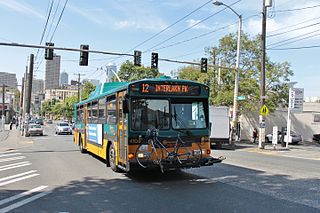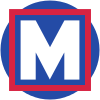Related Research Articles
Metro Transit is the primary public transportation operator in the Minneapolis–Saint Paul area of the U.S. state of Minnesota and the largest operator in the state. The system is a division of the Metropolitan Council, the region's metropolitan planning organization (MPO), averaging 264,347 riders each weekday, carrying 90% to 95% of the transit riders in the region on a combined network of regular-route buses, light rail and commuter rail. The remainder of Twin Cities transit ridership is generally split among suburban “opt-out” carriers operating out of cities that have chosen not to participate in the Metro Transit network. The biggest opt-out providers are Minnesota Valley Transit Authority (MVTA), Maple Grove Transit and Southwest Transit. The University of Minnesota also operates a campus shuttle system that coordinates routes with Metro Transit services.

MetroLink is the Greater St. Louis Metropolitan light rail system serving Missouri and the Metro East area of Illinois. The system consists of two lines connecting St. Louis Lambert International Airport and Shrewsbury, Missouri with Scott Air Force Base near Shiloh, Illinois, Washington University, Forest Park, and Downtown St. Louis. The system features 38 stations and is the only light rail system in the country to cross state lines. As of the third quarter of 2020, it is second only to Minneapolis Metro Transit in the Midwestern United States in terms of light rail ridership, and is the 11th-largest light rail system in the country.

The Metro Green Line is an 11-mile (18 km) light rail line that connects the central business districts of Minneapolis and Saint Paul in Minnesota as well as the University of Minnesota. An extension is under construction that will extend the line to the southwest connecting St. Louis Park, Hopkins, Minnetonka and Eden Prairie. The line follows the path of former Metro Transit bus route 16 along University Avenue and Washington Avenue. It is the second light-rail line in the region, after the Blue Line, which opened in 2004 and connects Minneapolis with the southern suburb of Bloomington.

The Waterfront Streetcar, officially the George Benson Waterfront Streetcar Line, was a heritage streetcar line run by King County Metro in Seattle, Washington, United States. It traveled for 1.6-mile (2.6 km) along Alaskan Way on the city's waterfront facing Elliott Bay, under the Alaskan Way Viaduct. The Waterfront Streetcar used a fleet of five W2 trams from Melbourne, Australia.

The Third Street Light Rail Project was the construction project that expanded the Muni Metro system in San Francisco, California, linking downtown San Francisco to the historically underserved southeastern neighborhoods of Bayview-Hunters Point and Visitacion Valley along the eastern side of the city. Construction was finished in late 2006, non-revenue weekend service began on January 13, 2007, and full service began on April 7, 2007. The new service, as the T Third Street Metro line, replaced the 15 Third bus line, which ran south from the Caltrain Depot at 4th and King streets, along Third Street and Bayshore Boulevard to the southeastern neighborhoods.

The Los Angeles Metro Rail is an urban rail transportation system serving Los Angeles County, California. It consists of six lines, including two subway lines and four light rail lines serving 93 stations. It connects with the Metro Busway bus rapid transit system and also with the Metrolink commuter rail system.

Metro East is a region in southern Illinois that comprises the eastern suburbs of St. Louis, Missouri, United States. It encompasses five Southern Illinois counties in the St. Louis Metropolitan Statistical Area. The region's most populated city is Belleville, with 45,000 residents. The Metro East is the second largest urban area in Illinois after the Chicago metropolitan area and, as of the 2000 census, the population of the Metro East statistical area was 599,845 residents, a figure that has risen above 700,000 in 2010. The significant growth in the Metro East is mainly due to people in smaller outlying towns in Illinois moving to the area for better economic/job opportunities.

Metro Transit is an enterprise of Bi-State Development, an interstate compact formed by Missouri and Illinois in 1949. Its operating budget in 2016 was $280 million, which is funded by sales taxes from the City of St. Louis and St. Louis County, the St. Clair County Illinois Transit District, federal and state grants and subsidies, and through fare paying passengers.

The Regional Connector Transit Project is a 1.9 mi (3.1 km) light rail subway tunnel under construction in Downtown Los Angeles. It is designed to connect the existing Metro Rail A (Blue) and E (Expo) Lines at 7th Street/Metro Center station to the existing L (Gold) Line and Union Station. When completed, the project will provide a one-seat ride into the core of Downtown LA for passengers on these lines who currently need to transfer, and will reduce or eliminate transfers for many passengers traveling across the region via downtown.

Madison County Transit, or MCT for short, is a bus and bike trail transportation system that serves the citizens of Madison County, which is located in Illinois approximately 20 miles (32 km) northeast of St. Louis. It was created in 1980 by the Madison County Board to improve transportation in Madison County, and is a completely separate transit system from the St. Louis Metro Transit system which includes MetroLink, which doesn't operate into Madison County, though the buses connect with many MetroBus routes and even serve MetroLink stations in East St. Louis, Belleville and Downtown St. Louis.

The K Line is an 8.5 miles (13.7 km) under-construction light rail line that will run through southwest Los Angeles, in a north to south direction. It will connect the Crenshaw neighborhood and Leimert Park to the City of Inglewood and Los Angeles International Airport (LAX). When completed, the line will be a part of the Los Angeles County Metro Rail System.

The Red Line is the older and longer line of the MetroLink light rail service in St. Louis, Missouri, United States. It serves 28 stations in Greater St. Louis.
The St. Charles Corridor is a proposed light rail route for the St. Louis MetroLink light rail system in St. Louis, Missouri, United States.
The St. Louis Commuter Rail is a series of proposed commuter rail lines being developed by Metro's Moving Transit Forward Plan.

The Sepulveda Pass Transit Corridor is a two-phased planned heavy rail transit corridor connecting the Los Angeles Basin to the San Fernando Valley through the Sepulveda Pass in Los Angeles, California, by supplementing the existing freeway. The corridor would partly parallel I-405, and proposed alternatives include heavy rail subway and monorail connecting the G Line in the Valley to the D Line and E Line on the Westside, and the Crenshaw/LAX Line near Los Angeles International Airport.
Transportation in Greater St. Louis includes road, rail, and air transportation modes connecting the communities in the area with domestic and international transportation networks. Parts of Greater St. Louis also support a public transportation network that includes bus and light rail service.

The RapidRide G Line is a future RapidRide bus service in Seattle, Washington, operated by King County Metro on Madison Street between Downtown Seattle and Madison Valley. The line is projected to open for service in 2024 and cost $133.4 million.
The West Santa Ana Branch Transit Corridor is a planned light rail line, mostly following the historic Pacific Electric West Santa Ana Branch, connecting Downtown Los Angeles to the City of Artesia and other cities in southeastern Los Angeles County.
The Crenshaw Northern Extension Rail Project is a planned Los Angeles Metro Rail light rail transit corridor extension connecting Expo/Crenshaw station to Hollywood/Highland station in Hollywood. The corridor is a north to south route along mostly densely populated areas of the Los Angeles Basin; it would be operated as part of the K Line. The Los Angeles County Metropolitan Transportation Authority (Metro) is prioritizing the project along with pressure from the West Hollywood residents. Construction is slated to start in 2041 and begin service by 2047 unless means to accelerate the project are found.
The Vermont Transit Line is a proposed 12.5-mile (20.1 km) bus rapid transit (BRT) or heavy rail subway line in the Metro Busway network in Los Angeles, California. It is planned to operate on a north to south route on Vermont Avenue between the B Line's Vermont/Sunset station and the C Line's Vermont/Athens station on the Metro Rail system. The project feasibility study was released in February 2019 with a proposed completion date of 2028 for BRT and after 2067 for rail. It is part of Metro's Twenty-eight by '28 initiative and is partially funded by Measure M. The route will have signal priority at traffic lights and will have a dedicated right of way. Metro reports the initial cost is $425 million.
